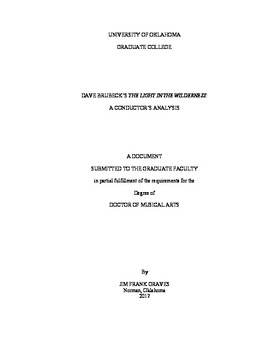| dc.description.abstract | The Light in the Wilderness was the first sacred choral work of renowned jazz legend, Dave Brubeck. At the time of its premier in 1968 he was 47 years old and known only as a jazz pianist. It was the success of this piece that led to the composition of seventeen major choral works, seven choral fugues, more than sixty-five miscellaneous vocal compositions, and more than forty-two chorale/anthems. After breaking up his most famous quartet–including Paul Desmond, Joe Morello, and Eugene Wright–Brubeck dedicated himself to writing large-scale “Classical” compositions. Although his jazz trio/quartet performance break was short lived, his compositional output was considerable. The premier performance of The Light in the Wilderness received tremendous success and was soon taken on tour in Europe. A thorough analysis of this work reveals a creative sense of text driven thematic and formal development using a variety of compositional constructs.
This document will provide a conductor’s analysis of the historical and musical material surrounding Brubeck’s oratorio, The Light in the Wilderness. Some analyses of this composition and other related material exists. This document expands and analyzes anew the work and provide a framework for a pedagogical approach to its preparation and performance. Correspondence with the Brubeck family and those who worked closely with Dave Brubeck contributes insights into the compositional mind of the composer and the musical commentary that he imbued on the scriptural text that was set.
The Light in the Wilderness is a stunning composition that demonstrates Dave Brubeck’s expansive compositional breadth. Brubeck makes use of quintal harmonies, tone rows, modal melodies, polyrhythms, polytonality, and chromaticism throughout. He uses jazz style and harmony, world music, and improvised meditations. With all of these constructs in place Brubeck still manages to uniformly align his message and take the listener on a coherent journey through the temptations and teachings of Christ. Brubeck should be recognized for his significant contribution to the twentieth-century American choral-orchestral repertoire. | en_US |
